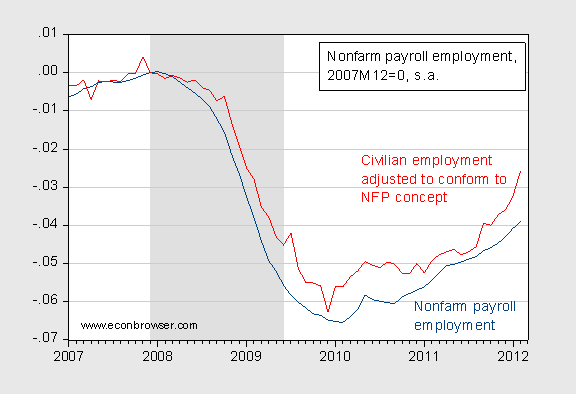I’m sure there’s a way to spin the February employment release in a negative way — see for instance JEC Republican vice-chair Brady’s take here — but I think it looks pretty good for a recovery after a combination financial crisis/housing bust/recession. [1]

Figure 1: Log nonfarm payroll employment (dark blue), and log household employment series adjusted to conform to nonfarm payroll employment (red), seasonally adjusted, rescaled to 2007M12=0. NBER defined recession dates shaded gray. Source: BLS via FRED, BLS, NBER and author’s calculations.
Note that were civilian employment to be included, it would exhibit a similar trend to the red line. In other words, the household survey is signalling more rapid recovery than the establishment survey.
Figure 2 shows that aggregate hours in the private sector have recovered, now more so than employment.

Figure 2: Log private employment (dark blue), and log aggregate weekly hours index in private sector, series AWHI (red), seasonally adjusted, rescaled to 2007M12=0. NBER defined recession dates shaded gray. Source: BLS via FRED, NBER and author’s calculations.
yes, but shouldn’t someone be asking about these numbers vs. say, these?
http://www.gallup.com/poll/153161/Unemployment-February.aspx
If you read the link to Brady’s release, he ends by saying: “Didn’t Einstein define insanity as doing the same thing over and over again and expecting different results? That describes the approach the administration has taken on the economy these past three years to a tee.”
Umm, wouldn’t that better apply to the idea that tax cuts, especially for the rich, stimulate the economy? Or that tax cuts generate growth that offsets their cost? The debt doubled under GWBush BEFORE the financial crisis. The GOP response: we need more tax cuts & those tax cuts will stimulate the economy so we don’t need to worry about those projections they’ll increase the debt.
Yup. Budget deficit = tax cuts. Budget surplus = tax cut. Healthy economy = tax cuts. Bad economy = tax cuts. It’s about shrinking the beast, as David Stockman famously acknowledged in the ’80s. Economic and fiscal reality are immaterial.
February had the largest monthly budget deficit ever, around $229 billion. U.S. payrolls increased by 227,000 in Feb. That’s somewhat more than $1 million per job. Is this what a recovery looks like?
Just good civility.
State & Local Government: Personal Income Tax Receipts (ASLPITAX)
http://research.stlouisfed.org/fred2/series/ASLPITAX
Non deflated
Federal Government: Tax Receipts on Corporate Income (FCTAX)
http://research.stlouisfed.org/fred2/series/FCTAX
Real Disposable Personal Income (DSPIC96)
http://research.stlouisfed.org/fred2/series/DSPIC96
and
Consumer Price Index for All Urban Consumers: All Items (CPIAUCSL)
http://research.stlouisfed.org/fred2/series/CPIAUCSL
Then ?
i guess the Fed has lowered expectations to the point where what once would have been considered pitiful, is now “something that looks pretty good.” I bet there are 15 million americans who disagree.
US Non-Farm Employment Climbs … to 140,000 below February 2009 Levels.
bob: Yup. And household series adjusted to the NFP concept is +296 thousand, relative to 2009M02. Note that the gradient also matters (the gradient is the first derivative of the level).
JOLTS Data – Can we call this the Obama recovery? 😉
The rebound looks very soft in Hires: http://data.bls.gov/generated_files/graphics/JTS10000000HIR_47810_1331585921604.gif
Seperations are on the rise after bottoming:
http://data.bls.gov/generated_files/graphics/JTS10000000LDR_47810_1331585921678.gif
Quits are rising, which is normally a good sign:
http://data.bls.gov/generated_files/graphics/JTS10000000QUR_47810_1331585921793.gif
Vacancies look the best:
http://data.bls.gov/generated_files/graphics/JTS10000000JOR_47810_1331585921869.gif
The employment recovery looks pretty anemic, with vacancies offering a glimmer of hope that firms are at least thinking about hiring. I think the current upside suprises in the national employment data were weather driven [ unusually warm 😉 and pulled some hiring from Q2 to Q1] and will turn into downside surprises in Q2. Last weeks unemployment claims data may have been the first hint of this.